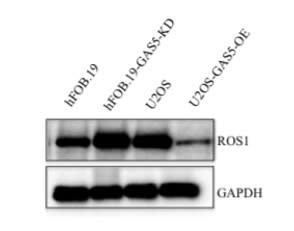- Datasheet
- References (6)
- Inventor Info
Info
| Catalogue Number | 151666 |
| Applications | IHC IF IP Fn WB |
| Antigen/Gene or Protein Targets | cROS |
| Reactivity | Human |
| Relevance |
Monoclonal antibody directed against cROS, a proto-oncogene with therapeutic target potential. Background and Research Application c-ROS is a proto-oncogene tyrosine kinase, that is highly-expressed in a variety of tumour cell lines and belongs to the sevenless subfamily of tyrosine kinase insulin receptor genes. It is a type I integral membrane protein and may function as a growth or differentiation factor receptor. The c-ROS gene promoter region has been identified and characterized and it has been shown that the ectopic expression of c-ROS in tumours is tied to hypomethylation of a CpG island in the c-ROS promoter. Tumours with ROS1 mutations are typically responsive to small molecule tyrosine kinase inhibitors. |
| Host | Mouse |
| Immunogen | Extracellular portion of ROS amino acid 1-285 fused to Fc, transiently expressed in 293 cells and purified using PtnA column chromatography. |
| Immunogen UniProt ID | P08922 |
| Positive Control | Cells transiently expressing human cROS, mouse cells expressing human cROS |
| Subclass | IgG1 |
| Myeloma Used | Sp2/0-Ag14 |
| Recommended Growing Conditions | DMEM + 20% FCS low IgG |
| Notes |
Production Details Purified using multi-step affinity chromatography with protein A. Storage Conditions Store at -20 degrees frozen. Avoid repeated freeze/thaw cycles. Points of Interest An intra-chromosomal deletion del(6)(q21q21) is responsible for the formation of GOPC-ROS1 chimeric protein which has a constitutive receptor tyrosine kinase activity. Concentration 1mg/ml as standard |
| Research Area | Cancer, Cell Signaling & Signal Transduction, Epigenetics & Nuclear Signalling |
References: 6 entries
Fei et al. 2019. Biosci Rep. 39(6):. PMID: 31138757.
WB
Zhang et al. 2019. Int J Biol Sci. 15(7):1460-1471. PMID: 31337976.
WB
Shih et al. 2017. Oncogene. 36(47):6542-6554. PMID: 28759046.
WB
Deng et al. 2014. Int J Mol Med. 34(3):661-8. PMID: 24968753.
IHC WB
Charest et al. 2003. Proc Natl Acad Sci U S A. 100(3):916-21. PMID: 12538861.
Oncogenic targeting of an activated tyrosine kinase to the Golgi apparatus in a glioblastoma.
Europe PMC ID: 12538861
Add a reference
References: 6 entries
Fei et al. 2019. Biosci Rep. 39(6):. PMID: 31138757.
WB
Zhang et al. 2019. Int J Biol Sci. 15(7):1460-1471. PMID: 31337976.
WB
Shih et al. 2017. Oncogene. 36(47):6542-6554. PMID: 28759046.
WB
Deng et al. 2014. Int J Mol Med. 34(3):661-8. PMID: 24968753.
IHC WB
Charest et al. 2003. Proc Natl Acad Sci U S A. 100(3):916-21. PMID: 12538861.
Oncogenic targeting of an activated tyrosine kinase to the Golgi apparatus in a glioblastoma.
Add a reference





![Image thumbnail for Anti-cROS [4-6G]](https://res.cloudinary.com/ximbio/image/upload/c_fit,fl_lossy,q_auto/a59e4e8a-3050-46b4-81b0-bfad92c456d2.jpg)
![Image thumbnail for Anti-cROS [4-6G]](https://res.cloudinary.com/ximbio/image/upload/c_fit,fl_lossy,q_auto/c664fece-97d3-4650-b3fa-7dd9f2acd6dc.jpg)
![Image thumbnail for Anti-cROS [4-6G]](https://res.cloudinary.com/ximbio/image/upload/c_fit,fl_lossy,q_auto/208803dd-1986-4800-b5b4-1d5ca7ab252e.jpg)
![Image thumbnail for Anti-cROS [4-6G]](https://res.cloudinary.com/ximbio/image/upload/c_fit,fl_lossy,h_45,q_auto/a59e4e8a-3050-46b4-81b0-bfad92c456d2.jpg)
![Image thumbnail for Anti-cROS [4-6G]](https://res.cloudinary.com/ximbio/image/upload/c_fit,fl_lossy,h_45,q_auto/c664fece-97d3-4650-b3fa-7dd9f2acd6dc.jpg)
![Image thumbnail for Anti-cROS [4-6G]](https://res.cloudinary.com/ximbio/image/upload/c_fit,fl_lossy,h_45,q_auto/208803dd-1986-4800-b5b4-1d5ca7ab252e.jpg)

